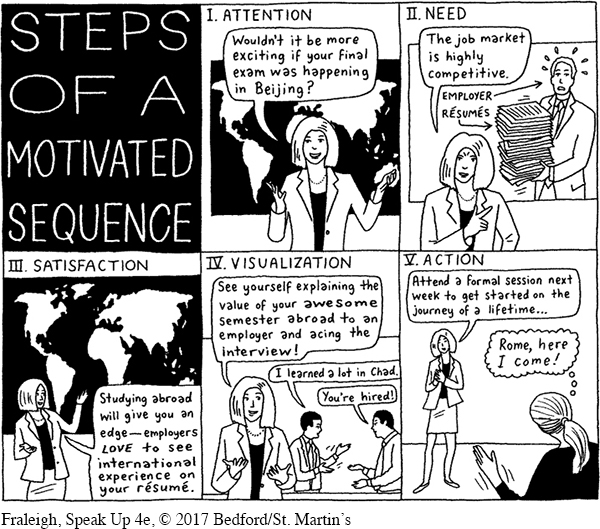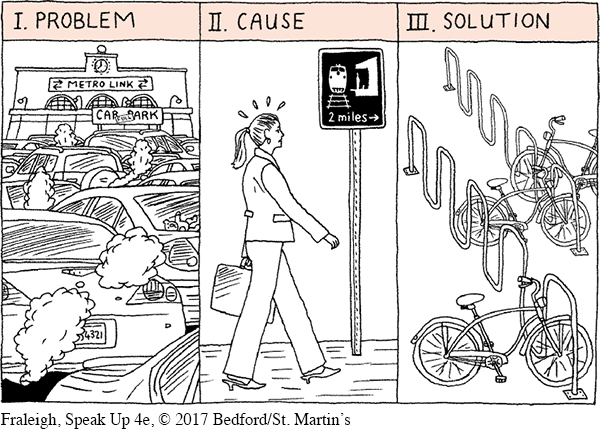Organizing Policy Claims
529
When you advance a policy claim, you call for action. You might want audience members to do something in particular, or you might want to convince them that an organization or institution (such as a state or local government) should take a particular action. For this type of persuasive speech, you can use a motivated sequence or problem-
Monroe’s Motivated Sequence. Developed by Alan Monroe nearly eighty years ago, this organizational pattern remains popular.28 Monroe’s motivated sequence follows the stages of thinking that people often go through while solving a problem or considering new ideas.29 A motivated sequence aims to establish five main points, as shown in the following example from a persuasive speech encouraging students to study abroad:
MAIN POINTS
Attention (creating a willingness to listen to your message). Few members of our class are looking forward to final exams next month. Do you think it would be more exciting if your finals were happening in Rome, Beijing, Sydney, or Buenos Aires?
Need (identifying a need relevant to your audience). Every member of this class plans to get a job after graduation. The job market is highly competitive.
Satisfaction (showing how your proposal will fulfill the need you identified). Participating in our college’s Study Abroad Program will strengthen your credentials in the job market. Employers report that they are more likely to hire a candidate with international experience.
Visualization (helping listeners form a mental picture of the benefits of your proposal). Imagine that you have returned to the United States after an amazing semester in Spain or Japan. At an interview for a job you really want, the interviewer asks if you have experience with other cultures. You answer yes, and you see the interviewer’s interest perk up. The next day, the company makes you an offer.
Action (clarifying what you want listeners to do). Attend an informational session on next year’s Study Abroad Program in the Student Union next Wednesday. You can learn more about the exciting options open to you, hear from past participants, and ask questions. After that, I hope you will decide to make Montreal, Mumbai, or Madrid your home for next fall.
530

To see an example of a presentation using Monroe’s motivated sequence, try Video Activity 17.2: “Patterns of Arrangement, Monroe’s Motivated Sequence,” which is used in a persuasive speech about radio frequency identification (RFID) technology.
Problem-
531
532

Here is an example of how a speaker might use this pattern in a persuasive speech advocating the installation of public bike racks near bus stops and train stations:
| THESIS | The local government should install secure bike racks near heavily used bus stops and train stations. |
MAIN POINTS
Problem. Parking is scarce, and traffic is congested near commuter bus stops and train stations in our county.
Cause. Many suburban commuters who would take mass transit live more than a mile from the closest bus stop or train station.
Solution. Providing secure bike racks will encourage alternative means of transportation to and from stops and stations, opening up parking spaces and alleviating traffic.